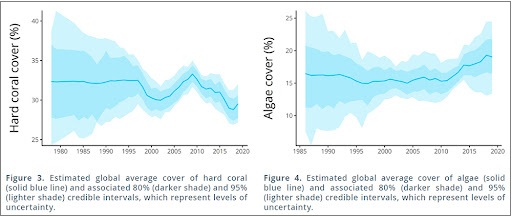- ABOUT US
- PROGRAM AREAS
- CONSERVATION APPROACH
- EDUCATION
- MULTIMEDIA
- strengthen scientific understanding of the status and trends of coral reef ecosystems at different places around the world;
- strengthen communication among members and provide information on network activities, opportunities to participate in regional and global reporting, and relevant meetings;
- provide members with technical assistance; and, make coral reef monitoring data publicly available online in a timely fashion.
The Global Coral Reef Monitoring Network- Charting a Course Toward Data Interoperability
By Erica K. Towle, Ph.D., National Coral Reef Monitoring Program Coordinator
The Global Coral Reef Monitoring Network (GCRMN) was established by the International Coral Reef Initiative (ICRI) in 1995 with the primary task of reporting on the condition of the world's coral reefs. The GCRMN works through a global network of stakeholders coordinated by regional nodes for the management and conservation of coral reefs. The major goals of the GCRMN are to:

In March 2022, the GCRMN Steering Committee* met in the Principality of Monaco as part of Monaco Ocean Week from March 22-24. Over 20 people participated in person and 11 people participated virtually. The countries of Australia, Monaco, France, the United States, the United Kingdom, the United Arab Emirates, Sri Lanka, Switzerland, Kenya, Ecuador, the Maldives, Palau, and more were represented at the meeting.

As NOAA Coral Reef Conservation Program's National Coral Reef Monitoring Program Coordinator, I have attended the GCRMN Steering Committee meetings and workshops since 2019. The most recent meeting in Monaco was a special one, not only because it was the first in-person meeting since the pandemic began, but it was also the first in-person meeting since the United States became the International Coral Reef Initiative's co-chair.
The meetings centered around continued momentum from the release of the Global Coral Reef Status Report that GCRMN published in October 2021. This report was the first global report since 2008, and took over two years to complete. One of the biggest challenges was compiling data contributed by more than 300 members of the network. The global dataset spanned more than 40 years from 1978 to 2019, and consisted of almost two million observations from more than 12,000 sites, in 73 reef-bearing countries around the world.

Out of all those data points, two indicators (hard coral cover and algae cover) were chosen for the report because they could be standardized and compared on a global scale. The process also identified gaps, like fisheries and socioeconomic data.

A major outcome of the Monaco meetings was a commitment to increasing data interoperability. In other words, standardizing data formats as much as possible so that future reports won't take as long to collate. Ultimately, the goal is to produce global reports more frequently in a way that doesn't involve significant data translation and processing. To do this, the group decided to build on global, community recognized data standards like Darwin Core. The Darwin Core Standard offers a stable, straightforward, and flexible framework for compiling biodiversity data from varied and variable sources. Darwin Core is an evolving, community-developed biodiversity data standard that plays a fundamental role in the sharing, use, and reuse of open-access biodiversity data. In practice, using Darwin Core revolves around a standard file format that enables data publishers to share their data using a common terminology. This standardization not only simplifies the process of publishing biodiversity datasets, but it also makes it easy for users to discover, search, evaluate, and compare datasets.
The GCRMN Steering Committee believes using Darwin Core will improve data interoperability for future reports and will pursue this option in the coming months. If the status report can be produced more frequently, it can be used to inform global and regional policies for coral reef ecosystem conservation and management at a faster pace. This is an exciting development for the field of coral reef conservation - stay tuned for updates on our progress!
*The GCRMN Steering Committee is comprised of a Global Coordinator, a UN Environment representative, the ICRI Host Secretariat representatives (co-chairs), major supporter country representatives, and representatives from the regional networks (e.g., Western Indian Ocean, Pacific, East Asia, Eastern Tropical Pacific, Caribbean, etc.) The Steering Committee tries to meet 1-2 times a year.
Related Stories and Products
About Us

The NOAA Coral Reef Conservation Program was established in 2000 by the Coral Reef Conservation Act. Headquartered in Silver Spring, Maryland, the program is part of NOAA's Office for Coastal Management.

The Coral Reef Information System (CoRIS) is the program's information portal that provides access to NOAA coral reef data and products.
Work With US
U.S. Coral Reef Task Force
Funding Opportunities
Employment
Fellowship Program
Contracting Assistance
Graphic Identifier
Featured Stories Archive

Access the archive of featured stories here...
Feedback
Thank you for visiting NOAA’s Coral Reef Conservation Program online. Please take our website satisfaction survey. We welcome your ideas, comments, and feedback. Questions? Email coralreef@noaa.gov.
Stay Connected
Contact Us
NOAA’s Coral Reef Conservation Program
SSMC4, 10th Floor
1305 East West Highway
Silver Spring, MD 20910
coralreef@noaa.gov
